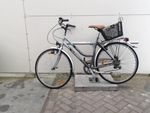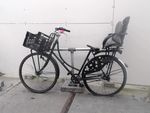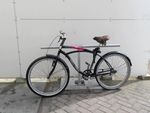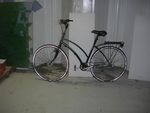HALLUCINATION IN OBJECT DETECTION - A STUDY IN VISUAL PART VERIFICATION
←
→
Page content transcription
If your browser does not render page correctly, please read the page content below
HALLUCINATION IN OBJECT DETECTION — A STUDY IN VISUAL PART VERIFICATION
Osman Semih Kayhan? Bart Vredebregt§ Jan C. van Gemert?§
?
Computer Vision Lab, Delft University of Technology and § Aiir Innovations
Faster RCNN RetinaNet
ABSTRACT
We show that object detectors can hallucinate and detect
arXiv:2106.02523v1 [cs.CV] 4 Jun 2021
missing objects; potentially even accurately localized at their
expected, but non-existing, position. This is particularly prob- IoU 0.86 IoU 0.83
lematic for applications that rely on visual part verification:
detecting if an object part is present or absent. We show how
popular object detectors hallucinate objects in a visual part Yolov3
IoU 0.84
verification task and introduce the first visual part verifica-
tion dataset: DelftBikes1 , which has 10,000 bike photographs,
with 22 densely annotated parts per image, where some parts
may be missing. We explicitly annotated an extra object state
label for each part to reflect if a part is missing or intact. We
propose to evaluate visual part verification by relying on re-
call and compare popular object detectors on DelftBikes.
Fig. 1. Hallucination examples on DelftBikes for Faster
Index Terms— Visual part verification, object detection
RCNN [11], RetinaNet [12] and YOLOv3 [13]. Faster RCNN
and RetinaNet detect the front wheel and YOLOv3 predicts
1. INTRODUCTION the saddle with a high IoU score. Deep object detectors may
detect non-existent objects at their expected locations.
Automatically localizing and detecting an object in an image
is one of the most important applications of computer vision.
It is therefore paramount to be aware that deep object detec- There are important differences between visual verifica-
tors can hallucinate non-existent objects, and they may even tion and object detection. An object detector should not de-
detect those missing objects at their expected location in the tect the same object multiple times. For visual verification,
image, see Fig. 1. Detecting non-existing objects is particu- however, the goal is to determine if an object is present or
larly detrimental to applications of automatic visual part ver- absent, and thus having an existing object detected multiple
ification or visual verification: determining the presence or times is not a problem, as long as the object is detected at
absence of an object. Examples of visual verification include least once. This makes recall more important than precision.
infrastructure verification in map making, missing instrument Moreover, there are differences in how much costs a mistake
detection after surgery, part inspections in machine manufac- has. The cost for an existing object that is not detected (false
turing etc. This paper shows how popular deep detectors hal- negative) is that a human needs to check the detection. The
lucinate objects in a case study on a novel, specifically created cost for a missing object that is falsely hallucinated as being
visual object part verification dataset: DelftBikes. present (false positive) is that this object is a wrongly judged
Visual verification as automatic visual inspection is typi- as intact and thus may cause accidents in road infrastructure,
cally used for manufacturing systems with applications such or may cause incomplete objects to be sent to a customer. The
as checking pharmaceutical blister package [1], components costs for hallucinating missing objects is higher than missing
on PCBs [2, 3], solder joint [4], parts of railway tracks [5], an existing object. These aspects motivate us to not use the
rail bolts [6], aeronautic components [7, 8], objects [9], and evaluation measure of object detection. Object detectors are
parts under motion [10]. In this paper, we do not focus on a typically evaluated with mean Average Precision (mAP) and
particular application. Instead, we evaluate generic deep ob- because detections of non-existent objects at lower confidence
ject detectors which potentially can be used in several visual levels does not significantly impact mAP, the problem of ob-
inspection applications. ject hallucination has largely been ignored. Here, we propose
to evaluate visual verification not with precision but with a
1 https://github.com/oskyhn/DelftBikes cost-weighted variant of recall.a b c d e
f g h i j
Fig. 2. Example images of our DelftBikes visual verification dataset. Each image has a single bike with 22 bounding box
annotated parts. The similar pose, orientation and position can be misleading for context-sensitive detectors as often one or two
parts are missing (the saddle in (a), the wheels in (e) etc.).
Object hallucination by deep detectors can be causes by The distribution of part states is approximately similar for
sensitivity to the absolute position in the image [14, 15] while training and testing set, see Fig. 3. The part state distribu-
also affected by scene context [16, 17, 18, 19, 20]. Here, we tion shows 60.5% intact, 19.5% absent, 14% occluded, and
focus on the visual verification task, its evaluation measure, a 6% damaged. The front pedal, dress guard, chain and back
novel dataset, and a comparison of popular existing detectors. light have respectively the highest number of intact, absent,
Investigating context is future work. occluded and damaged part states. Note that even if a part is
Existing object detection datasets such as PASCAL absent or occluded, we still annotate its most likely bounding
VOC [21], MS-COCO[22], Imagenet-det [23], and Open box location. DelftBikes contains positional and contextual
Image [24] have no annotated object parts. Pascal-Parts [25] biases. In Fig. 4 where we plot an ellipse for each part in the
and GoCaRD [26] include part labels, yet lack information dataset in terms of their mean position, height and width. It is
if a part is missing and where, as is required to evaluate possible to recognize the shape of a bike, which indicates that
visual verification. Thus, we collected a novel visual verifi- there are strong part-to-part position and contextual relations.
cation dataset: DelftBikes where we explicitly annotate all Its those biases that learning systems may falsely exploit and
part locations and part states as missing, intact, damaged, or cause detector hallucinations.
occluded.
We have the following contributions:
1. We demonstrate hallucination in object detection for 3
popular object detectors. 60 Training
Testing
2. A dataset of 10k images with 22 densely annotated 50
State Ratio (%)
parts specifically collected and labeled for visual verification.
40
3. An evaluation criteria for visual verification.
30
2. DELFTBIKES VISUAL VERIFICATION DATASET 20
DelftBikes (See Fig. 2) has 10,000 bike images annotated 10
with bounding box locations of 22 different parts where each 0
part is in one of four possible states: intact damaged occluded absent
Object States
intact: The part is clearly evident and does not indicate any
sign of damage. All the images in Fig. 2 have an intact steer. Fig. 3. The distribution of part states for train and test sets
damaged: The part is broken or has some missing parts. in DelftBikes. The ratio of part states are roughly similar for
In Fig. 2-g, the front part of the saddle is damaged. train and test sets. The intact parts have the highest ratio by
absent: The part is entirely missing and is not occluded. around 60%. Approximately 20% of parts in the dataset are
Fig. 2-e has missing front and back wheels. absent. The damaged and occluded parts constitute 20%.
occluded: The part is partially occluded because of an exter-
nal object or completely invisible. The saddle in Fig. 2-b is
covered with a plastic bag.Average part locations Class-Specific Results (IoU @0.5:0.95)
back wheel Methods
back handle Faster RCNN
back break front wheel RetinaNet
bell front mudguard YOLO
steer
front break back mudguard
front handle saddle saddle
front light gear case
back reflector chain
lock steer
dynamo dress guard back light kickstand
front mudguard back mudguard dress guard
back wheel
lock
front wheel gearcase back handle
Parts
back pedal
chain front pedal
front pedal kickstand dynamo
back light
front light
front handle
Fig. 4. Averaging position and size for all 22 parts in Delft- back reflector
Bikes resembles a bicycle, illustrating the prior in absolute back hand break
position and the contextual part relations. front hand break
back pedal
bell
3. EXPERIMENTS ON DELFTBIKES AP
AP50
The dataset is randomly split in 8k for training and 2k for test- 0.0 0.1 0.2 0.3 0.4 0.5 0.6 0.7 0.8 0.9
ing. We use a COCO pretrained models of Faster RCNN [11] Results
and RetinaNet [12]. Both networks have a Resnet-50 [27]
backbone architecture with FPN. The networks are finetuned Fig. 5. Object detection results on DelftBikes. Results per
with DelftBikes for 10 epochs using SGD with a initial learn- category and overall performance. Notice that half of the de-
ing rate of 0.005. The YOLOv3 [13] architecture is trained tections are below 20% AP score. In most of the cases, Faster
from scratch for 200 epochs using SGD with an initial learn- RCNN and RetinaNet perform similarly and YOLOv3 is be-
ing rate of 0.01. Other hyperparameters are set to their de- hind them.
faults. We group the four part states in two categories for
visual verification: (i) missing parts consist of absent and oc-
cluded states and (ii) present parts include intact and damaged
states. During training, only parts with present states are used. of detected missing part at a given IoU threshold and the to-
Detection. We first evaluate traditional object detection tal number of missing parts.We show recall for varying IoU
using AP. For object detection, the missing parts are not used threshold for each method in Fig. 6. For a reasonable IoU
during training nor testing. In Fig. 5, we show results for an of 0.5, RetinaNet and YOLOv3 detect approximately 20%
IoU of 0.5:0.95 for the 3 detectors. For most of the classes, of missing parts and Faster RCNN 14%. Without looking
Faster RCNN and RetinaNet obtain approximately a similar at position, (IoU=0), RetinaNet and YOLOv3 detect as much
result and YOLOv3 is a bit behind. Front wheel and back as almost 80% of missing parts. Interestingly, Faster RCNN,
wheel are large and well detected. The small parts like bell with similar mAP object detection score as RetinaNet, detects
and dynamo have under 12% AP score because they are small only 32% of missing parts. For Faster RCNN, the most hal-
parts and often not present. The other parts are below 50% lucinated part with 14% is gear case. For YOLOv3, a miss-
AP, where half of the parts have less than 20% AP, which ing dynamo is most detected and RetinaNet hallucinates most
makes DelftBikes already a challenging and thus interesting about the dress guard.
object detection dataset.
Recall of missing parts. Here, we analyze the halluci- Evaluating visual verification. For visual verification,
nation failure of the detectors by evaluating how many non- we want high recall of present parts and low recall of missing
existing parts they detect in an image. We calculate the IoU parts where detecting the same object multiple times does not
score for each detected missing part on the test set. We thresh- matter. Besides, wrongly detected missing parts (false posi-
old these false detections in terms of their IoU scores to eval- tives) cost more than not detected present parts (false nega-
uate if the missing parts are still approximately localized. We tives). Thus, our Fvv evaluation score is based on recall and
define the recall score which is the ratio between the number inspired by the Fβ score [28] so we can weight detection mis-Accumulated Recall of missing parts
1.0 Method TP TM RP RM Fvv
Faster RCNN
With localization
RetinaNet
0.8 YOLOv3 Faster RCNN 0.5 0.1 0.83 0.28 0.72
RetinaNet 0.5 0.1 0.90 0.62 0.38
0.6
YOLOv3 0.5 0.1 0.83 0.64 0.36
Recall
Without localization
0.4 Faster RCNN 0.0 0.0 0.92 0.32 0.68
RetinaNet 0.0 0.0 0.99 0.79 0.21
YOLOv3 0.0 0.0 0.95 0.77 0.23
0.2
MCML 0.0 0.0 0.91 0.32 0.68
0.0 Table 1. Visual verification of Faster RCNN, RetinaNet,
0.9 0.8 0.7 0.6 0.5 0.4 0.3 0.2 0.1 0.0
IoU thresholds YOLOv3 and MCML for different present (T P ) and missing
(T M ) IoU thresholds on DelftBikes. (top) When (T P , T M )
Fig. 6. Recall of missing parts on DelftBikes for varying In- equals to (0.5, 0.1): RetinaNet has highest recall for present
tersection over Union (IoU). We annotated likely position of parts. Faster RCNN detects the fewest missing parts and
missing parts, and the recall of such missing parts should be has best Fvv score. (bottom) When localization is discarded:
as low as possible. All methods wrongly detect missing parts MCML method outperforms RetinaNet and YOLOv3 and re-
at approximately their expected location, as in Fig. 1. sults similarly Faster RCNN in Fvv score.
takes differently as Faster RCNN is almost 2 times higher than RetinaNet. Reti-
naNet has 7% more intact recall score than YOLOv3, how-
(1 + β 2 )RP (1 − RM ) ever, the difference for Fvv is only 2%. For the without local-
Fvv = . (1)
β 2 (1 − RM ) + RP ization results, when the present and missing IoU thresholds
are set to 0, all the methods obtain more than 90% present
RP is the present recall and RM the missing recall calculated
recall. Interestingly, the MCML method, which only needs
at a certain IoU threshold. The β parameter allows to weight
full image class labels, outperforms RetinaNet and YOLOv3
the detection mistakes, where we set the β parameter to 0.1
detectors and performs similar to Faster RCNN.
so that detections of missing parts are 10x more costly than
not detected present parts.
Visual verification results. Visual verification perfor- 4. DISCUSSION AND CONCLUSION
mance is estimated by using the recall of present and missing
parts. We have two setups for visual verification calculation: We show hallucinating object detectors: Detectors can detect
with and without localization. Visual verification with local- objects that are not in the image even with a high IoU score.
ization: the present recall has an IoU threshold of 0.5, where We show hallucination in the context of a visual part veri-
the missing recall is less relying on position and we set its fication task. We introduce DelftBikes, a novel visual ver-
IoU threshold to 0.1. Visual verification without localization: ification dataset, with object class, bounding box and state
we set all IoU thresholds to 0. This, in addition, allows us labels. We evaluate visual verification by recall, where the
to evaluate a full-image multi-class multi-label classification cost of falsely detected missing parts is more expensive than
(MCML) approach. An Imagenet pretrained ResNet-50 ar- a missing present part. For object detection, Faster RCNN
chitecture is fine-tuned with BCE with logits loss and SGD and RetinaNet has similar AP score, however, Faster RCNN
with an initial learning rate of 0.05 for 15 epochs. After every is the better for visual verification.
5 epoch, the learning rate is reduced by a factor of 10. The One limitation of our work is that the human annotations
network obtains 91% of recall for present parts and 32% of for the non-existing parts are partly guesswork. Taking this
recall for missing parts. into account, this makes it even more surprising that detectors
Results are shown in Table 1. For the with localization predict with such a high IoU score.
results, Faster RCNN outperforms RetinaNet and YOLO in
terms of lower recall of missing parts by 28% and a higher
Fvv score by 72%. RetinaNet and YOLOv3 detects more than 5. REFERENCES
60% of missing parts and achieve only 38% and 36% of Fvv
score respectively. In Fig. 5, the AP scores of Faster RCNN [1] R. G. Rosandich, “Automated visual inspection sys-
and RetinaNet are quite similar, yet the Fvv performance of tems,” in Intelligent Visual Inspection. 1997. 1[2] Hugo C Garcia and J Rene Villalobos, “Automated [16] Ehud Barnea and Ohad Ben-Shahar, “Exploring the
refinement of automated visual inspection algorithms,” bounds of the utility of context for object detection,” in
IEEE T-ASE, 2009. 1 CVPR, 2019. 2
[3] Dusan Koniar, Libor Hargas, Anna Simonova, Miroslav [17] Spyros Gidaris and Nikos Komodakis, “Object de-
Hrianka, and Zuzana Loncova, “Virtual instrumentation tection via a multi-region and semantic segmentation-
for visual inspection in mechatronic applications,” Pro- aware cnn model,” in ICCV, 2015. 2
cedia Engineering, 2014. 1
[18] Yong Liu, Ruiping Wang, Shiguang Shan, and Xilin
[4] Tae-Hyeon Kim, Tai-Hoon Cho, Young Shik Moon, and Chen, “Structure inference net: Object detection using
Sung Han Park, “Visual inspection system for the clas- scene-level context and instance-level relationships,”
sification of solder joints,” Pattern Recognition, 1999. CVPR, 2018. 2
1 [19] Yousong Zhu, Chaoyang Zhao, Jinqiao Wang, Xu Zhao,
[5] Esther Resendiz, John M Hart, and Narendra Ahuja, Yi Wu, and Hanqing Lu, “Couplenet: Coupling global
“Automated visual inspection of railroad tracks,” IEEE structure with local parts for object detection,” in ICCV,
transactions on ITS, 2013. 1 2017. 2
[6] F. Marino, A. Distante, P. L. Mazzeo, and E. Stella, [20] Krishna K. Singh, Dhruv Mahajan, Kristen Grauman,
“A real-time visual inspection system for railway main- Yong Jae Lee, Matt Feiszli, and Deepti Ghadiyaram,
tenance: automatic hexagonal-headed bolts detection,” “Don’t judge an object by its context: Learning to over-
IEEE Transactions on Systems, Man, and Cybernetics, come contextual bias,” arXiv:2001.03152, 2020. 2
2007. 1 [21] M. Everingham, L. Van Gool, C. K. I. Williams, J. Winn,
[7] H. Ben Abdallah, I. Jovančević, J.-J. Orteu, and and A. Zisserman, “The PASCAL VOC2012,” . 2
L. Brèthes, “Automatic inspection of aeronautical me- [22] Tsung-Yi Lin, Michael Maire, Serge Belongie, James
chanical assemblies by matching the 3d cad model and Hays, Pietro Perona, Deva Ramanan, Piotr Dollár, and
real 2d images,” Journal of Imaging, 2019. 1 C Lawrence Zitnick, “Microsoft coco: Common objects
in context,” in ECCV, 2014. 2
[8] Marco San Biagio, Carlos Beltran-Gonzalez, Salvatore
Giunta, Alessio Del Bue, and Vittorio Murino, “Auto- [23] Olga Russakovsky, Jia Deng, Hao Su, Jonathan Krause,
matic inspection of aeronautic components,” Machine Sanjeev Satheesh, Sean Ma, Zhiheng Huang, Andrej
Vision and Applications, 2017. 1 Karpathy, Aditya Khosla, Michael Bernstein, et al.,
“Imagenet large scale visual recognition challenge,”
[9] Albert-Jan Baerveldt, “A vision system for object
IJCV, 2015. 2
verification and localization based on local features,”
Robotics and Autonomous Systems, 2001. 1 [24] Alina Kuznetsova, Hassan Rom, Neil Alldrin, J, Jasper
R. R. Uijlings, Ivan Krasin, Jordi Pont-Tuset, Shahab
[10] SK Sim, Patrick SK Chua, ML Tay, and Yun Gao,
Kamali, Stefan Popov, Matteo Malloci, Tom Duerig,
“Recognition of features of parts subjected to motion
and Vittorio Ferrari, “The open images dataset V4:
using artmap incorporated in a flexible vibratory bowl
unified image classification, object detection, and vi-
feeder system,” AI EDAM, 2006. 1
sual relationship detection at scale,” CoRR, vol.
[11] Shaoqing Ren, Kaiming He, Ross Girshick, and Jian abs/1811.00982, 2018. 2
Sun, “Faster r-cnn: Towards real-time object detection [25] Xianjie Chen, Roozbeh Mottaghi, Xiaobai Liu, Sanja
with region proposal networks,” in NIPS, 2015. 1, 3 Fidler, Raquel Urtasun, and Alan Yuille, “Detect what
[12] Tsung-Yi Lin, Priya Goyal, Ross Girshick, Kaiming He, you can: Detecting and representing objects using holis-
and Piotr Dollár, “Focal loss for dense object detection,” tic models and body parts,” in CVPR, 2014. 2
in ICCV, 2017. 1, 3 [26] Lukas Stappen, Xinchen Du, et al., “Go-card – generic,
[13] Ali Farhadi and Joseph Redmon, “Yolov3: An incre- optical car part recognition and detection: Collection,
mental improvement,” CVPR, 2018. 1, 3 insights, and applications,” 2020. 2
[14] Marco Manfredi and Yu Wang, “Shift equivariance in [27] Kaiming He, Xiangyu Zhang, Shaoqing Ren, and Jian
object detection,” in ECCV workshop, 2020. 2 Sun, “Deep residual learning for image recognition,” in
CVPR, 2016. 3
[15] O.S. Kayhan and J.C. van Gemert, “On translation in-
[28] N. Chinchor, “Muc-4 evaluation metrics,” in MUC4.
variance in CNNs: Convolutional layers can exploit ab-
1992, Association for Computational Linguistics. 3
solute spatial location,” in CVPR, 2020. 2You can also read



























































